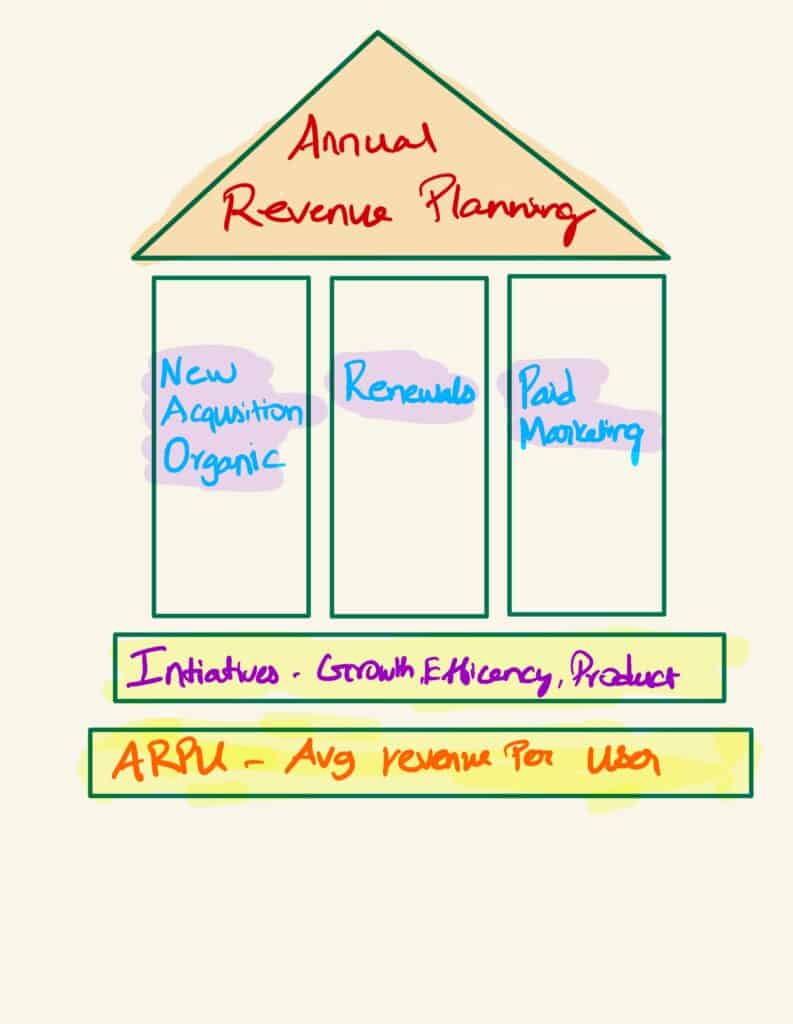There were multiple guides for annual planning for e-commerce, and SAAS business, when I was looking for a B2C subscription business there were not many. My humble approach to creating one, take it with a pinch of salt.
Annual planning is an exercise every company does before the start of their financial year, with big goals and aspirations that establish strategic themes for the company. There is no right or wrong way to do this.
For a B2C subscription business, this can be broken into aspects like
- Total MAU’s
- Premium Subscribers
- Retention/Renewals
The goal of Annual planning is to arrive at a revenue number that the organization aspires to achieve. Eg: In the year 2020 Quibi achieved $120 Mn in revenue, for the year 2021 they plan to achieve $250Mn.
Target for 2021 = BAU (Business As Usual) of 2020 + Delta
So for Quibi $250Mn = $120Mn + delta is $130Mn
BAU of 2020
In 2020 Quibi had achieved $120 Mn, so the business assumes that we will achieve $120 Mn this year by maintaining BAU.
There is another method to arrive at the BAU of 2020, taking the whole of 2020 revenue is misleading and you should only take only the last 4 months (L4M) growth % average, as that’s the real growth and extrapolate it to the next 12 months. More on this here, Pipecandy newsletter
Delta = Organic + Paid Acq
For any B2C business majority of is growth/revenue comes from Organic acquisition and paid acquisition.
New Acquisition Organic – Any user who is newly acquired organically
Paid Acq – Any user who is acquired through paid marketing
But in the case of subscription, you have another predictable variable – Renewals, any user who had to renew their subscription
Delta = New Acquisition Organic + Renewals + Paid Marketing

New Acquisition Organic:
For a healthy subscription business, it’s imperative you generate the majority of your revenue through organic new acquisition, attracting new relevant users, ensuring a healthy top of the funnel and keep optimizing.
The foundation for the annual plan to get it right is Initiatives and DRI, then map each of these to New acquisition organic, Renewals and Paid marketing. This ensures that the initiatives are balanced between New acquisitions and renewals.
Initiatives:
Broadly there can be 3 types of initiatives
- Growth-related (Increase app MAU, Expand to new markets, etc)
- Efficiency-related (Improve conversion %, retention, etc)
- Product-related (better onboarding, new features, etc)
Planning these Initiatives are very critical and also the hardest part as it involves multiple stakeholders and getting them aligned is another part of Annual planning which can be a whole different post altogether.
This is critical because in a year you have 52 weeks, if you take 3 weeks for shipping out a feature/experiment, (1 week planning, 2 week development & QA). You can take 17 shots in a year to make things work for you. If you apply the pareto 80-20 rule, out of these 17 shots, you essentially get only 4 things that will work for you.
DRI – Directly Responsible Individuals
There is a saying “If it’s not on paper, it didn’t happen” similarly for each of these initiatives to be successful there needs to be a direct responsible individual, if not it’s bound to fail, somethings are shared between teams, but the owner of the outcome can’t be two teams it should be one ideally an individual.
In short DRI is a person with whom the buck stops for each initiatives.
New Acquisition Organic:
This is basically increasing your top of the funnel and reducing the friction for the users to make a payment or take a free trial.
Renewals:
How much of the users are you able to retain this year. If Quibi has 1000 active users entering into 2021, how many of them are they able to retain is 75%, 45% or 25%.
To be continued…